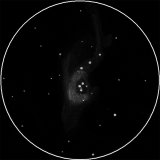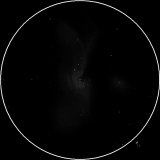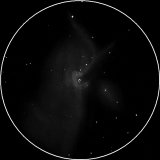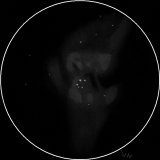
| MESSIER 43 (PART OF ORION NEBULA) |
|---|
RA: |
05h 35m 30s |
|
DEC: |
-05° 16' 00'' |
|
Type: |
Emission Nebula |
|
NGC: |
1982 |
|
Magnitude: |
9.00 |
|
Surface brightness : |
13.00 |
|
Apparent dimensions : |
20'x15' |
|
Distance: |
1,600 ly |
|
Discovered before 1731 by Jean-Jacques Dortous de Mairan. M43 is actually a part of the Great Orion Nebula, M42, which is separated from the main nebula by an impressive, turbulent dark lane. It was first reported by de Mairan in 1731 as a "brilliance surrounding a star" which he thought was "very similar to the atmosphere of our Sun, if it were dense enough and extensive enough to be visible in telescopes at a similar distance." Charles Messier included in his fine drawing of the Orion Nebula, and assigned it an extra catalog number, M43, on March 4, 1769. Moreover, William Herschel took it into his list with the number H III.1, although normally he careful avoided to assign his numbers to Messier Objects. In his 1811 paper, Herschel states to have observed it as early as March 4, 1774, and cataloged it on November 3, 1783. The diffuse nebula M43 surrounds the irregular young "nebula variable" NU Orionis (HD 37061, attn: "N" "U" Orionis, not "Nu Orionis", i.e. the variable star 2-letter designation, not the Greek letter) of magnitude 6.5-7.6 and spectral type B IV. It seems that M43 is excited to shine by this star, and contains its own, separate small cluster of stars which have formed in this part of the Orion nebula. The dark features along its eastern border are well visible in telescopes starting at about 8 inch. The nebula itself is a fine view even in a 4-inch.
|
||
Other sketches (M43 is part od M42) |
|||||
 |
 |
 |
 |
||
M42, 114x, Jan 2006. |
M42, 114x, Oct 2006. |
M42, 114x, Nov 2006. |
M42, 300x, Jan 2007. |
||
VEDRAN VRHOVAC© 2006.-2007. |